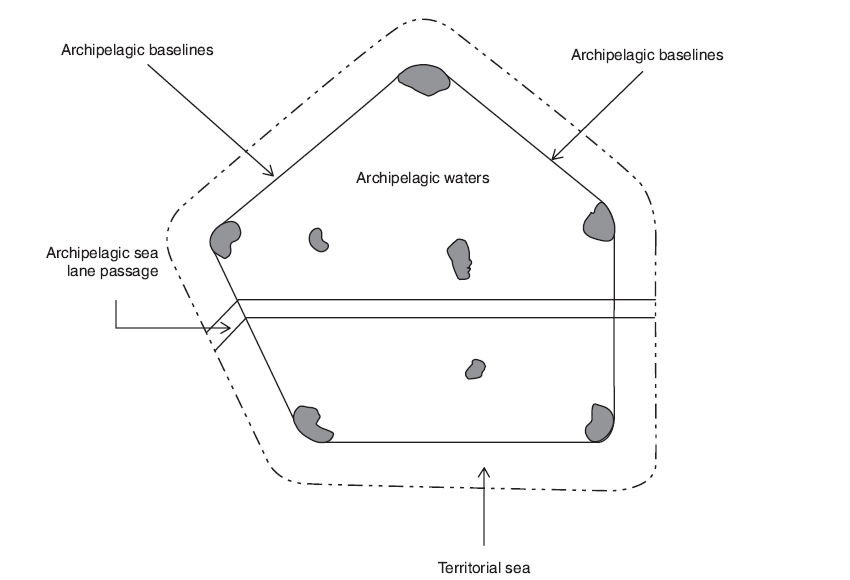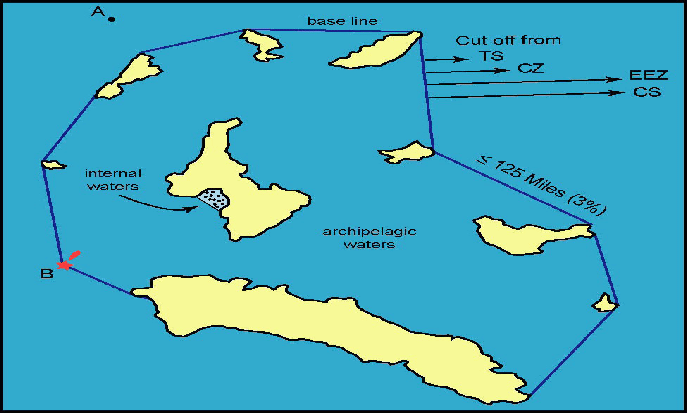The key concept of archipelagic waters is that a group of islands in mid-ocean, i.e. ‘midocean archipelagos’, should be considered as forming a unit; and that the waters enclosed by baselines joining the outermost points of the archipelago should be under territorial sovereignty. While the question of a special archipelagic regime has been discussed on various occasions since the early twentieth century, neither the 1930 Hague Conference, nor UNCLOS I could resolve this question. The 1958 Geneva Conventions contain no provision with regard to mid-ocean archipelagos or archipelagic waters.
At UNCLOS III, the question of a special regime for archipelagos was taken up in the broader context of the new international economic order. A group of archipelagic States – Fiji, Indonesia, Mauritius and the Philippines – vigorously promoted the special regime for archipelagos with a view to safeguarding their interests in the oceans, on the basis of (i) political and security interests, (ii) historical factors, (iii) natural features, (iv) economic interests, (v) environmental protection, and (vi) reasonableness. A legal regime for archipelagic States was gradually formulated, and was finally embodied in Part IV of the LOSC. It may be said that the legal regime for archipelagic waters is a result of the development of international law, not the codification of the law.
Definition of an Archipelago, Archipelagic States and Archipelagic Waters
Article 46(a) of the LOSC defines an archipelagic State as ‘a State constituted wholly by one or more archipelagos and may include other islands’. It follows that States possessing territory in a continent, i.e. mainland States, are not archipelagic States. For example, Greece is not an archipelagic State under the LOSC.
A key question is the meaning of the term ‘archipelago’. Article 46(b) defines ‘archipelago’ as follows:
‘Archipelago’ means a group of islands, including parts of islands, interconnecting waters and other natural features which are so closely interrelated that such islands, waters and other natural features form an intrinsic geographical, economic and political entity, or which historically have been regarded as such.
The definition contains four criteria which must be present in order for an island group to constitute an archipelago: (i) the existence of a group of islands, (ii) the compactness or the adjacency of islands, (iii) the existence of an intrinsic geographical, economic and political entity, and (iv) historical practice. Yet these criteria may not be wholly unambiguous. For instance, there is no criterion with regard to the minimum number of islands. It appears that ‘an economic and political entity’ does not always coincide with ‘a geographical entity’. The test of historicity may give rise to the question of how it is possible to demonstrate evidence in this matter.
Currently twenty-two States have formally claimed archipelagic status. Those States are:
Antigua and Barbuda, Bahamas, Cape Verde, Comoros, Dominican Republic, Fiji, Grenada, Indonesia, Jamaica, Kiribati, Maldives, Marshall Islands, Mauritius, Papua New Guinea, Philippines, Saint Vincent and the Grenadines, São Tomé and Príncipe, Seychelles, Solomon Islands, Trinidad and Tobago, Tuvalu and Vanuatu. All these States are parties to the LOSC.
‘Archipelagic waters’ mean the waters enclosed by the archipelagic baselines drawn in accordance with Article 47 regardless of their depth or distance from the coast. The breadth of the territorial sea, the contiguous zone, the EEZ and the continental shelf is to be measured from archipelagic baselines. Thus archipelagic waters must be distinguished from the territorial sea. Further, Article 50 stipulates that within its archipelagic waters, the archipelagic State may draw closing lines for the delimitation of internal waters in accordance with Articles 9, 10 and 11. The landward areas of these closing lines become internal waters of an archipelagic State. Hence, it must be stressed that archipelagic waters do not constitute internal waters.


